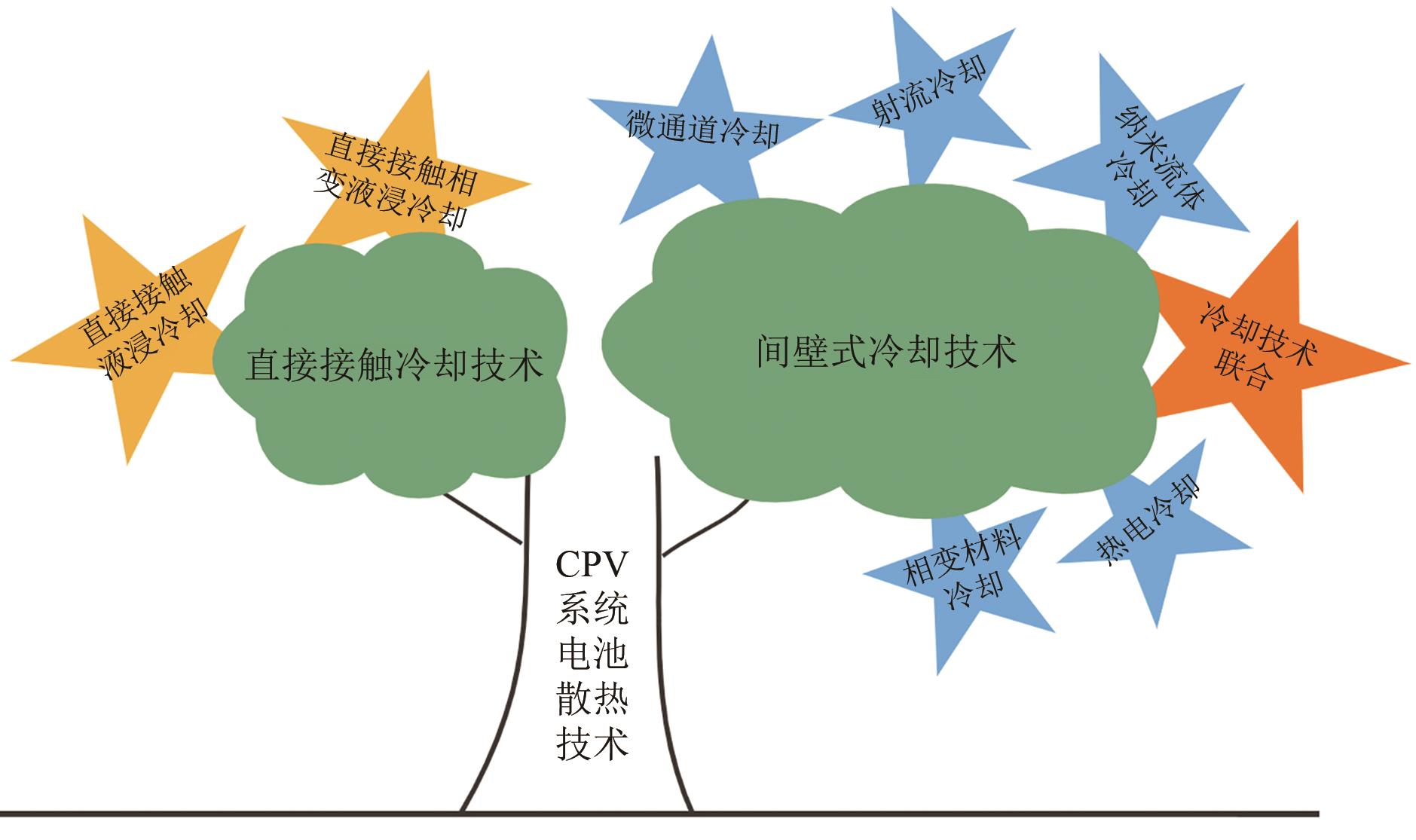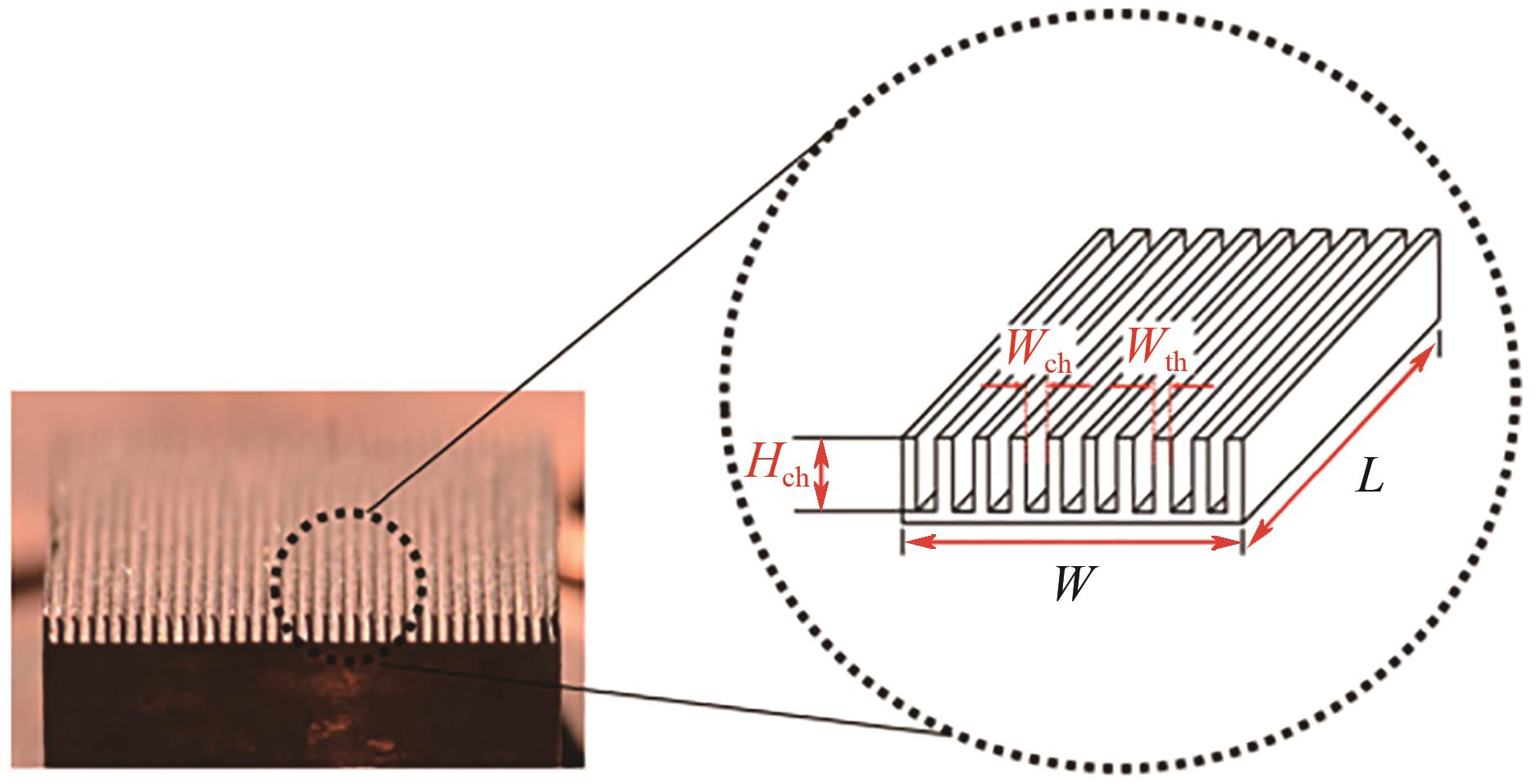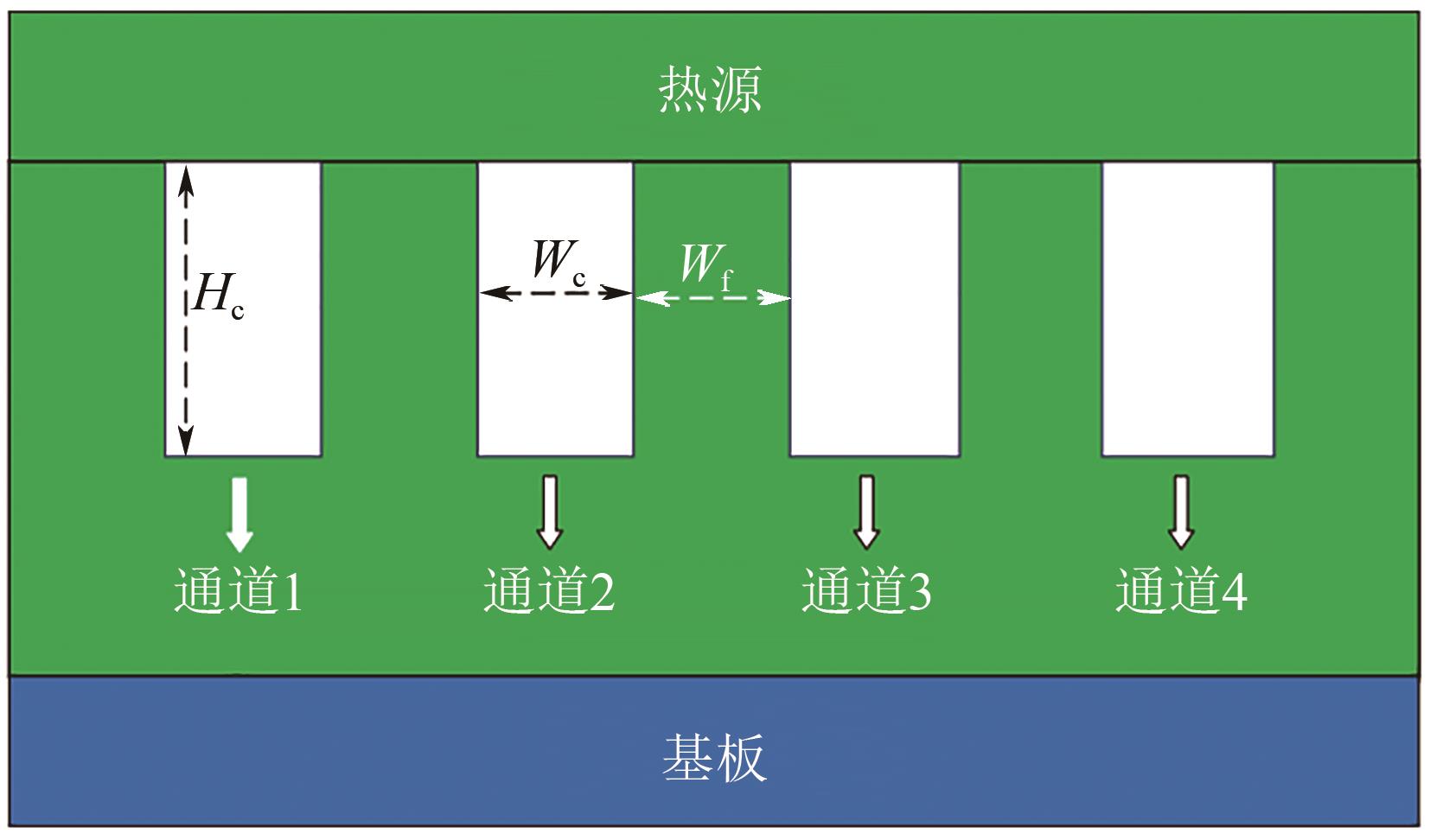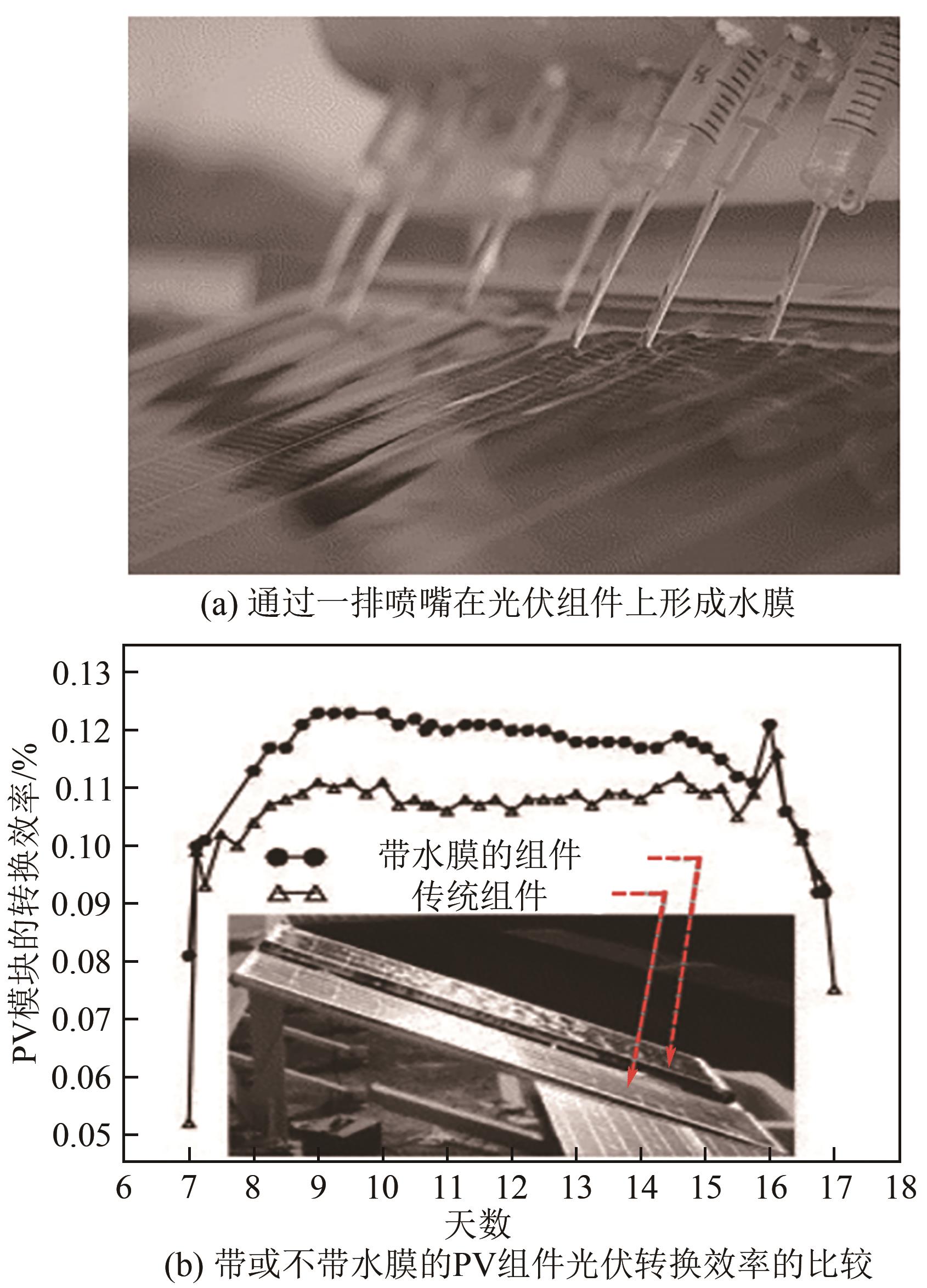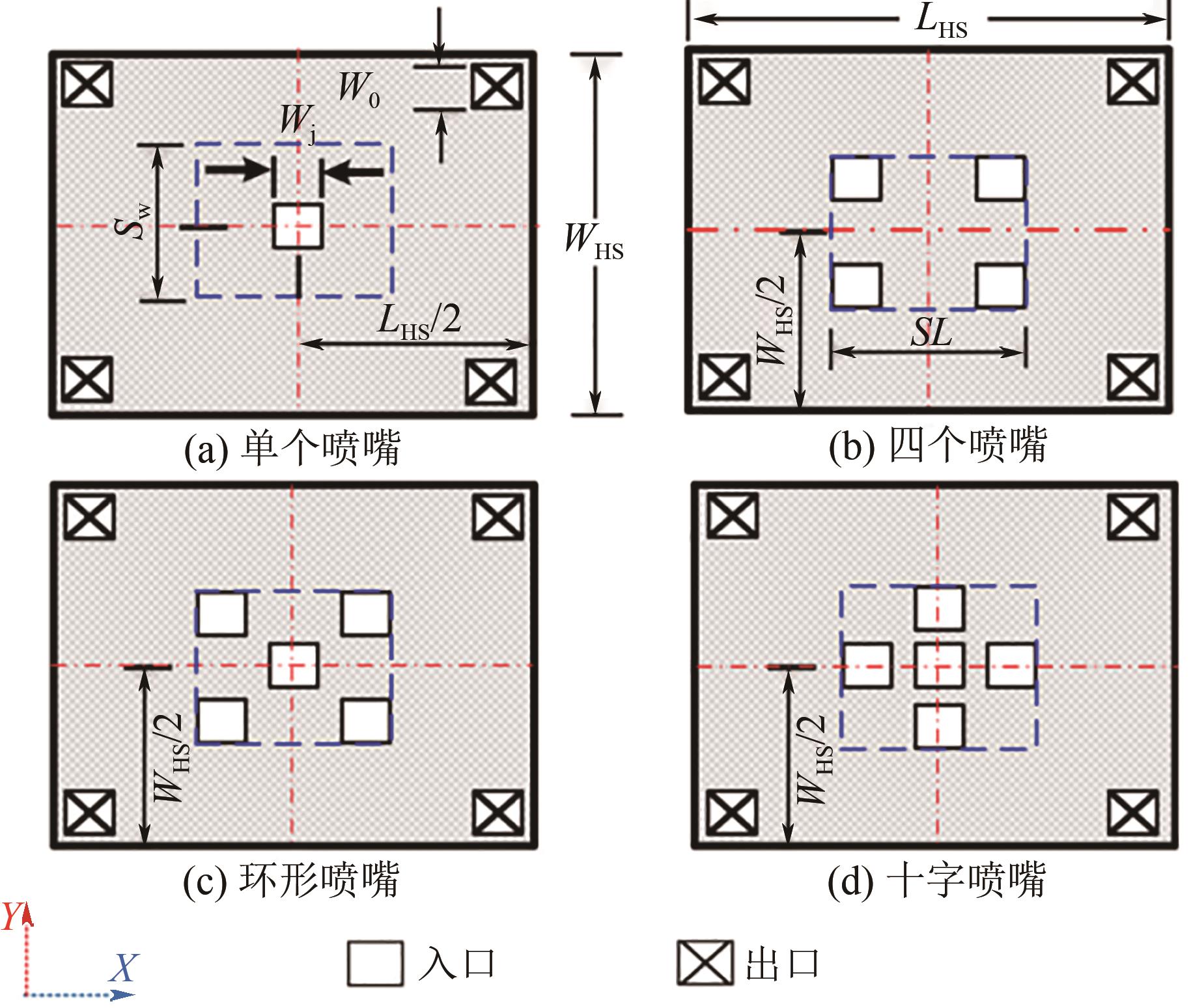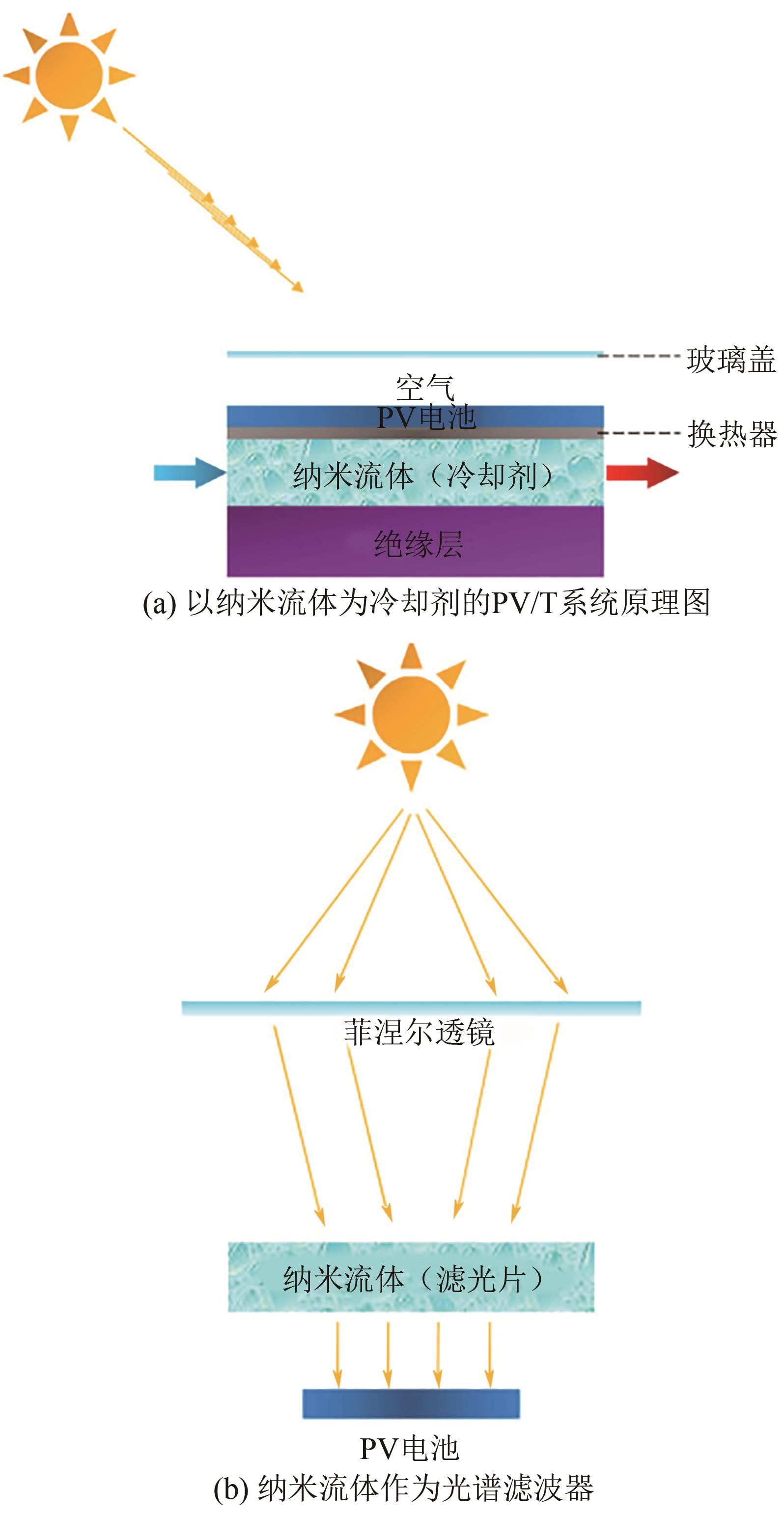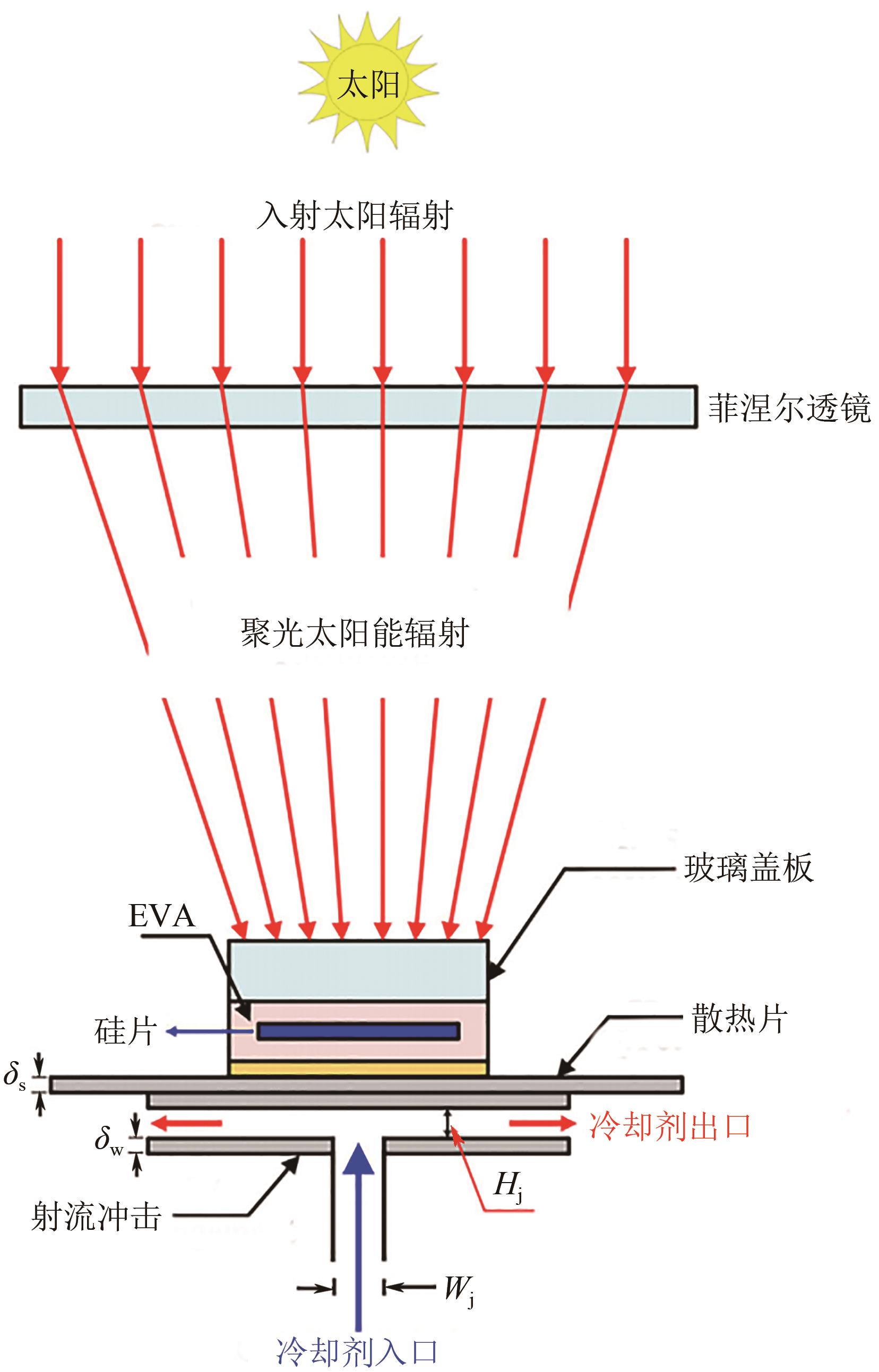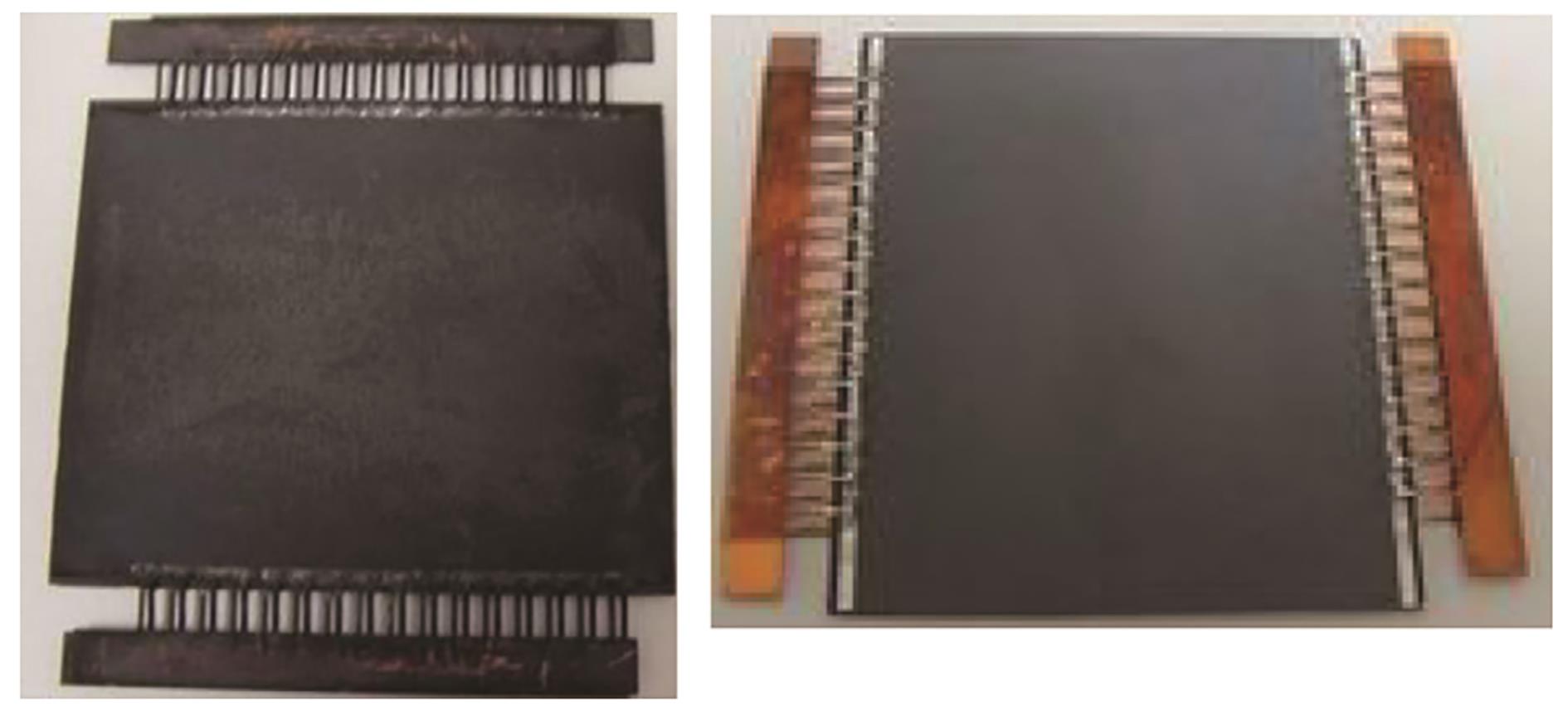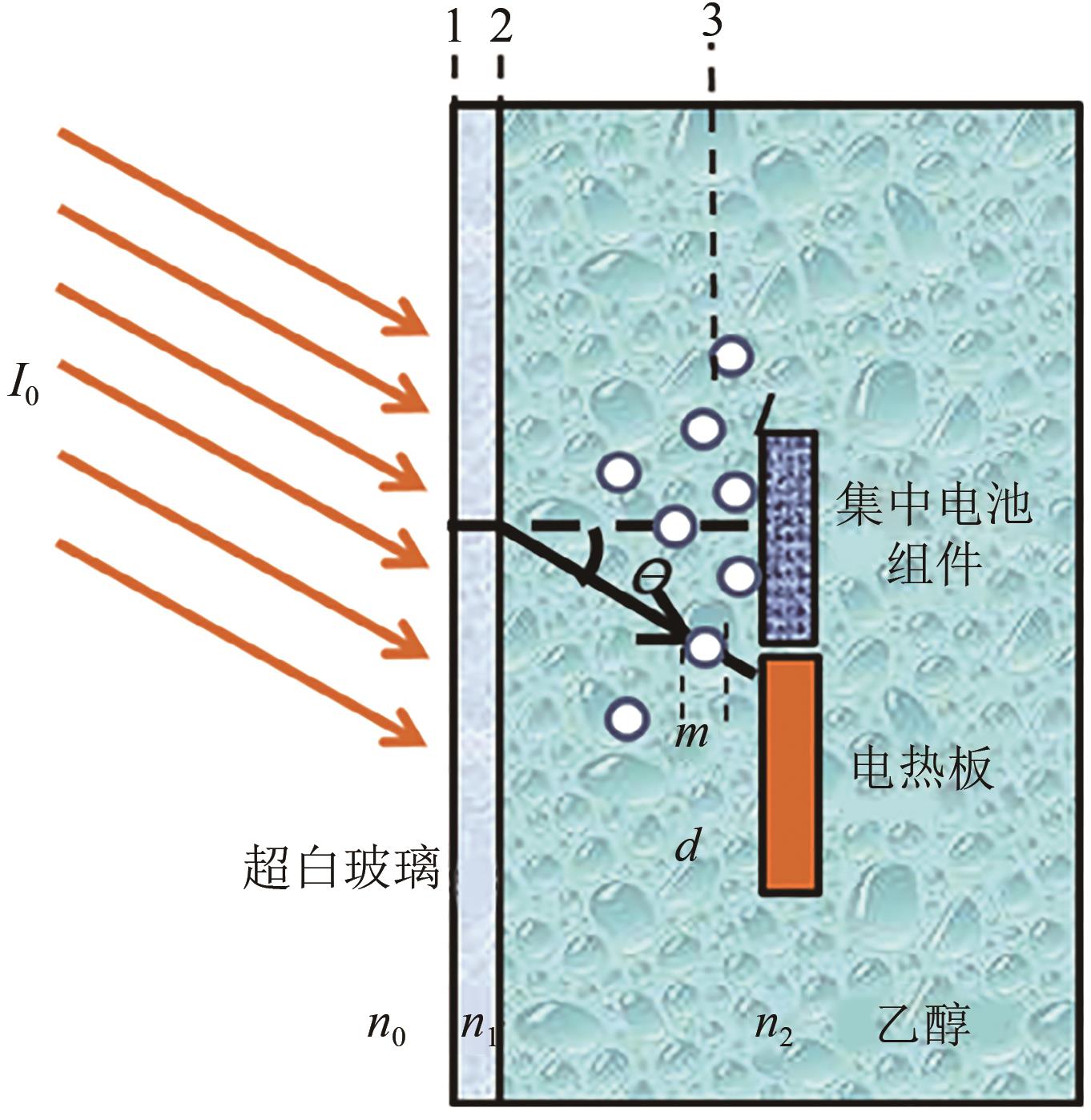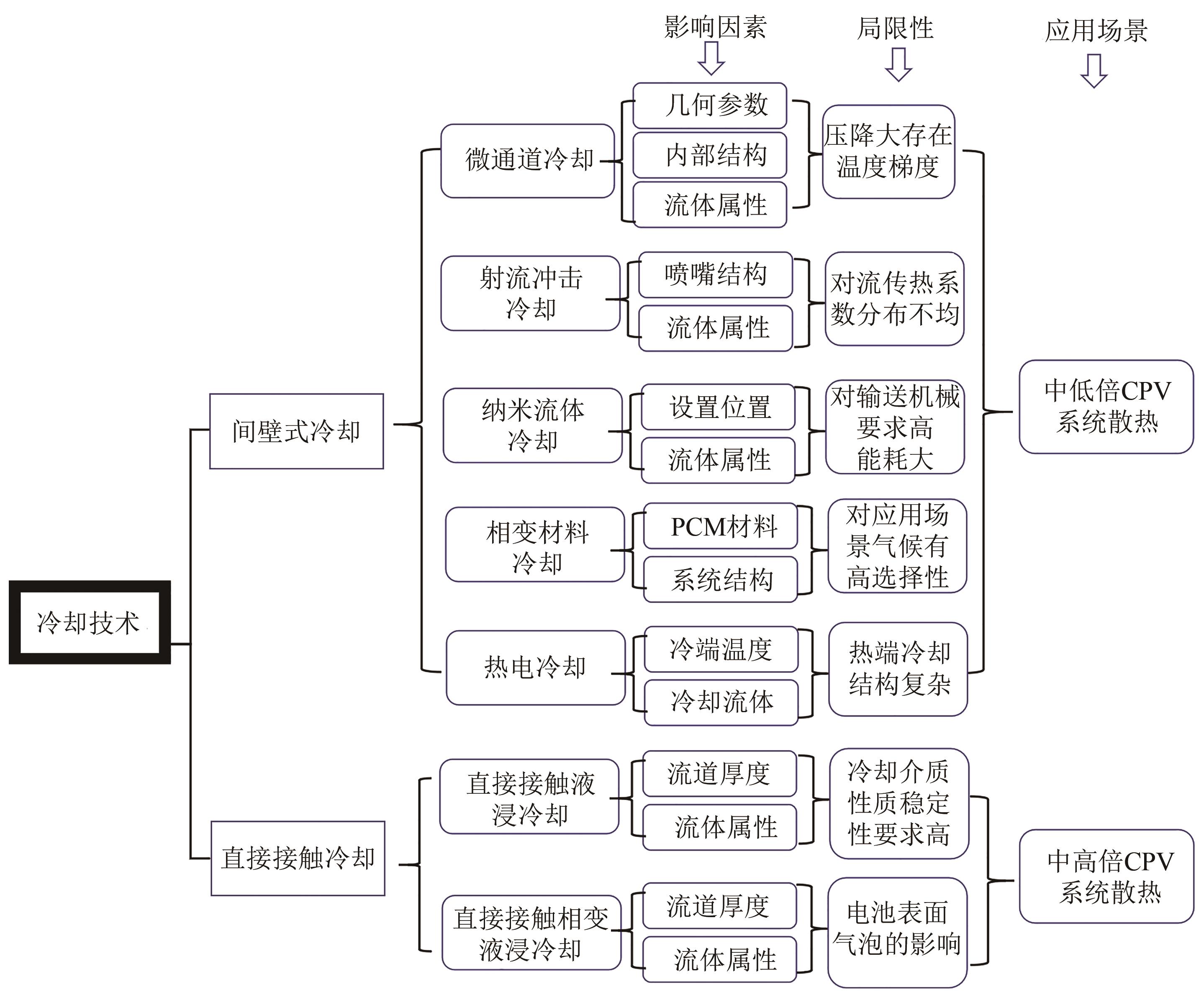化工进展 ›› 2023, Vol. 42 ›› Issue (1): 159-177.DOI: 10.16085/j.issn.1000-6613.2022-0191
聚光光伏系统太阳能电池散热技术及发展现状
白浩良1,2( ), 王晨1,2(
), 王晨1,2( ), 卢静1, 康雪2,3(
), 卢静1, 康雪2,3( )
)
- 1.中北大学环境与安全工程学院,山西 太原 030051
2.中北大学德州产业技术研究院,山东 德州 253000
3.中北大学化学与化工学院,山西 太原 030051
-
收稿日期:2022-02-06修回日期:2022-09-02出版日期:2023-01-25发布日期:2023-02-20 -
通讯作者:王晨,康雪 -
作者简介:白浩良(1997—),男,硕士研究生,研究方向为聚光光伏散热。E-mail:bhl050513@163.com。 -
基金资助:国家自然科学基金青年基金(21908208);博士后第67批面上项目(2020M670659);山西省自然科学基金青年基金(201901D211224);山西省高校创新基金(2019L0575)
Solar cell heat dissipation technology and development status of concentrating photovoltaic system
BAI Haoliang1,2( ), WANG Chen1,2(
), WANG Chen1,2( ), LU Jing1, KANG Xue2,3(
), LU Jing1, KANG Xue2,3( )
)
- 1.School of Environment and Safety Engineering, North University of China, Taiyuan 030051, Shanxi, China
2.Dezhou Industrial Technology Research Institute of North University of China, Dezhou 253000, Shandong, China
3.School of Chemistry and Chemical Engineering, North University of China, Taiyuan 030051, Shanxi, China
-
Received:2022-02-06Revised:2022-09-02Online:2023-01-25Published:2023-02-20 -
Contact:WANG Chen, KANG Xue
摘要:
低碳政策下新能源的高效利用势在必行,有效利用太阳能聚光光伏技术的核心为太阳能电池,太阳能电池对温度的变化非常敏感,高温会大幅降低太阳能电池的性能及寿命,因此,太阳能电池的有效散热是限制该技术发展的瓶颈。本文首先介绍了聚光太阳能电池散热的必要性及散热难题,随后根据电池结构和热沉装置之间是否存在壁面,从间壁式冷却和直接接触式冷却两个角度回顾了近年来国内外在电池冷却技术方面的研究现状及最新进展。最后,通过各冷却技术的冷却效果和电池性能增益对比分析了各冷却方式的优缺点和未来的研究重点,为聚光光伏系统太阳能电池的有效散热提供了参考与借鉴。
中图分类号:
引用本文
白浩良, 王晨, 卢静, 康雪. 聚光光伏系统太阳能电池散热技术及发展现状[J]. 化工进展, 2023, 42(1): 159-177.
BAI Haoliang, WANG Chen, LU Jing, KANG Xue. Solar cell heat dissipation technology and development status of concentrating photovoltaic system[J]. Chemical Industry and Engineering Progress, 2023, 42(1): 159-177.
| 纳米流体 | 聚光倍数 | 电池温度 | 电池性能增益 | 作者 |
|---|---|---|---|---|
| 3%Al2O3/H2O | 1.35倍 | <45℃(降低16.5℃) | 电效率提高38.5% | Elminshawy Ahmed等[ |
| 0.2%(质量分数)ZnO/H2O | — | — | 电输出提高7% | Abazar Abadeh等[ |
| 3%(质量分数)Fe3O4/H2O | 辐照度为1100W/m2 | — | 电效率提高4.8% | Matin Ghadiri等[ |
| 1%(质量分数)SiO2/H2O | 辐照度为1000W/m2 | 45℃(降低20℃) | 电效率增加12.7% | Ali Najah Al-Shamani等[ |
| 4%SiC/H2O | 20倍 | 降低8℃ | 电效率提高4.5% | Radwan等[ |
| 0.21%(质量分数)炭黑/H2O | — | 31.2℃(降低40.4℃) | 输出功率提高54% | Firoozzadeh Mohammad等[ |
| 0.05%(质量分数)GNP/H2O | 平均辐照度为865W/m2 | 33.3℃ | 电效率提高16% | Amin Taheri等[ |
表1 不同纳米流体的应用场景与冷却效果对比
| 纳米流体 | 聚光倍数 | 电池温度 | 电池性能增益 | 作者 |
|---|---|---|---|---|
| 3%Al2O3/H2O | 1.35倍 | <45℃(降低16.5℃) | 电效率提高38.5% | Elminshawy Ahmed等[ |
| 0.2%(质量分数)ZnO/H2O | — | — | 电输出提高7% | Abazar Abadeh等[ |
| 3%(质量分数)Fe3O4/H2O | 辐照度为1100W/m2 | — | 电效率提高4.8% | Matin Ghadiri等[ |
| 1%(质量分数)SiO2/H2O | 辐照度为1000W/m2 | 45℃(降低20℃) | 电效率增加12.7% | Ali Najah Al-Shamani等[ |
| 4%SiC/H2O | 20倍 | 降低8℃ | 电效率提高4.5% | Radwan等[ |
| 0.21%(质量分数)炭黑/H2O | — | 31.2℃(降低40.4℃) | 输出功率提高54% | Firoozzadeh Mohammad等[ |
| 0.05%(质量分数)GNP/H2O | 平均辐照度为865W/m2 | 33.3℃ | 电效率提高16% | Amin Taheri等[ |
| 冷却技术 | 聚光倍数 | 冷却效果 | 文献 | ||
|---|---|---|---|---|---|
| 热阻 | 电池温度 | 性能增益 | |||
| 微通道冷却 | 500倍 | — | 温升<10℃ | 总负载为CPV模块产生0.2%功率 | Reddy等[ |
| 微通道冷却 | 28倍 | 对流传热系数8235.84W/(m2·℃) | 20.4℃(降低23.7℃) | 电能增加5.97% | Yang等[ |
| 射流冲击冷却 | 辐照度为1000W/m2 | — | 33.7℃(降低30.3℃) | 系统输出功率增加47.67% | Javidan等[ |
| 射流冲击冷却 | 1000倍 | — | 最大局部温度65℃ (降低1295℃) | 电效率为39.57% | Abo-Zahhad等[ |
| 纳米流体冷却 (电池上方) | 辐照度为1000W/m2 | — | 40℃(降低20℃) | 最大输出功率降低11.55% | 寿春晖等[ |
| 纳米流体冷却 (电池下方) | 1.35倍 | — | 45℃(降低16.47℃) | 电效率提高38.50% | Elminshawy等[ |
| 纳米流体冷却 | — | — | 31.2℃(降低40.4℃) | 输出功率提高54% | Firoozzadeh等[ |
| 相变材料(PCM)冷却 | 辐照度为1000W/m2 | — | 降低6.4℃ | 输出功率提高19% | Sharma等[ |
| 热电冷却 | 辐照度为940W/m2 | — | 65℃ | 输出功率提高0.5% | Benghanem等[ |
| 射流冲击冷却+ 微通道冷却 | 20倍 | — | 87℃(降低21.7℃) | 电效率提高1.9% | Awad等[ |
| 纳米流体+微通道冷却 | — | — | 43℃(降低19℃) | 效率提高54% | Moh等[ |
| 纳米流体+PCM冷却 | 10倍 | — | 78℃(平均温度降低60%) | 效率提高2.7% | Nasef等[ |
表2 间壁式散热各技术应用场景与冷却效果对比
| 冷却技术 | 聚光倍数 | 冷却效果 | 文献 | ||
|---|---|---|---|---|---|
| 热阻 | 电池温度 | 性能增益 | |||
| 微通道冷却 | 500倍 | — | 温升<10℃ | 总负载为CPV模块产生0.2%功率 | Reddy等[ |
| 微通道冷却 | 28倍 | 对流传热系数8235.84W/(m2·℃) | 20.4℃(降低23.7℃) | 电能增加5.97% | Yang等[ |
| 射流冲击冷却 | 辐照度为1000W/m2 | — | 33.7℃(降低30.3℃) | 系统输出功率增加47.67% | Javidan等[ |
| 射流冲击冷却 | 1000倍 | — | 最大局部温度65℃ (降低1295℃) | 电效率为39.57% | Abo-Zahhad等[ |
| 纳米流体冷却 (电池上方) | 辐照度为1000W/m2 | — | 40℃(降低20℃) | 最大输出功率降低11.55% | 寿春晖等[ |
| 纳米流体冷却 (电池下方) | 1.35倍 | — | 45℃(降低16.47℃) | 电效率提高38.50% | Elminshawy等[ |
| 纳米流体冷却 | — | — | 31.2℃(降低40.4℃) | 输出功率提高54% | Firoozzadeh等[ |
| 相变材料(PCM)冷却 | 辐照度为1000W/m2 | — | 降低6.4℃ | 输出功率提高19% | Sharma等[ |
| 热电冷却 | 辐照度为940W/m2 | — | 65℃ | 输出功率提高0.5% | Benghanem等[ |
| 射流冲击冷却+ 微通道冷却 | 20倍 | — | 87℃(降低21.7℃) | 电效率提高1.9% | Awad等[ |
| 纳米流体+微通道冷却 | — | — | 43℃(降低19℃) | 效率提高54% | Moh等[ |
| 纳米流体+PCM冷却 | 10倍 | — | 78℃(平均温度降低60%) | 效率提高2.7% | Nasef等[ |
| 冷却技术 | 聚光倍数 | 冷却效果 | 作者 | ||
|---|---|---|---|---|---|
| 热阻 | 电池温度 | 电池性能增益 | |||
| 直接接触液浸冷却 | 160.8倍 202.9倍 | 3.3×10-4℃·m2/W | 45℃ | — | Zhu等[ |
| 直接接触液浸冷却 | 辐照度为47.3kW/m2 68.8kW/m2 | 1.0×10-4℃·m2/W | 30℃ 45℃ | — | Liu等[ |
| 直接接触液浸冷却 | 10~30倍 | — | 25℃ | 效率提高8.5%~15.2% | Han等[ |
| 直接接触液浸冷却 | 500倍 | — | <80℃ | 转换效率提高1.0% | Xin等[ |
| 直接接触相变液浸冷却 | — | 1.02×10-4℃·m2/W | 发光二极管结温为56.5℃ | — | Wang等[ |
| 直接接触相变液浸冷却 | 219.8~398.4倍 | 4.2×10-5℃·m2/W | 87.3~88.5℃ | Isc和Pmax分别下降10.2%和7.3% | Kang等[ |
表3 直接接触冷却技术应用场景与冷却效果对比
| 冷却技术 | 聚光倍数 | 冷却效果 | 作者 | ||
|---|---|---|---|---|---|
| 热阻 | 电池温度 | 电池性能增益 | |||
| 直接接触液浸冷却 | 160.8倍 202.9倍 | 3.3×10-4℃·m2/W | 45℃ | — | Zhu等[ |
| 直接接触液浸冷却 | 辐照度为47.3kW/m2 68.8kW/m2 | 1.0×10-4℃·m2/W | 30℃ 45℃ | — | Liu等[ |
| 直接接触液浸冷却 | 10~30倍 | — | 25℃ | 效率提高8.5%~15.2% | Han等[ |
| 直接接触液浸冷却 | 500倍 | — | <80℃ | 转换效率提高1.0% | Xin等[ |
| 直接接触相变液浸冷却 | — | 1.02×10-4℃·m2/W | 发光二极管结温为56.5℃ | — | Wang等[ |
| 直接接触相变液浸冷却 | 219.8~398.4倍 | 4.2×10-5℃·m2/W | 87.3~88.5℃ | Isc和Pmax分别下降10.2%和7.3% | Kang等[ |
| 1 | Amoco BP. BP Energy Outlook 2022[EB/OL]. [2022-08-24]. . |
| 2 | GREEN M A, EMERY K, KING D L, et al. Solar cell efficiency tables (version 22)[J]. Progress in Photovoltaics: Research and Applications, 2003, 11(5): 347-352. |
| 3 | ABO-ZAHHAD E M, OOKAWARA S, RADWAN A, et al. Numerical analyses of hybrid jet impingement/microchannel cooling device for thermal management of high concentrator triple-junction solar cell[J]. Applied Energy, 2019, 253: 113538. |
| 4 | 刘成, 沈璐颖, 徐郑羽, 等. 钙钛矿太阳电池的研究进展[J]. 化工进展, 2014, 33(12): 3246-3252. |
| LIU Cheng, SHEN Luying, XU Zhengyu, et al. Progress of perovskite solar cells[J]. Chemical Industry and Engineering Progress, 2014, 33(12): 3246-3252. | |
| 5 | SAHAY A, SETHI V K, TIWARI A C, et al. A review of solar photovoltaic panel cooling systems with special reference to ground coupled central panel cooling system (GC-CPCS)[J]. Renewable and Sustainable Energy Reviews, 2015, 42: 306-312. |
| 6 | SURESH A K, KHURANA S, NANDAN G, et al. Role on nanofluids in cooling solar photovoltaic cell to enhance overall efficiency[J]. Materials Today: Proceedings, 2018, 5(9, Part 3): 20614-20620. |
| 7 | SKOPLAKI E, PALYVOS J A. On the temperature dependence of photovoltaic module electrical performance: a review of efficiency/power correlations[J]. Solar Energy, 2009, 83(5): 614-624. |
| 8 | CHEMISANA D. Building integrated concentrating photovoltaics: a review[J]. Renewable and Sustainable Energy Reviews, 2011, 15(1): 603-611. |
| 9 | ROYNE A, DEY C, MILLS D R. Cooling of photovoltaic cells under concentrated illumination: a critical review[J]. Solar Energy Materials and Solar Cells, 2005, 86(4): 451-483. |
| 10 | KINSEY G S, EDMONDSON K M. Spectral response and energy output of concentrator multijunction solar cells[J]. Progress in Photovoltaics: Research and Applications, 2009, 17(5): 279-288. |
| 11 | ORTEGON J A A, SOUZA R R, SILVA J B C, et al. Analytical, experimental, and numerical analysis of a microchannel cooling system for high-concentration photovoltaic cells[J]. Journal of the Brazilian Society of Mechanical Sciences and Engineering, 2019, 41(6): 1-11. |
| 12 | TUCKERMAN D B, PEASE R F. High-performance heat sinking for VLSI[J]. IEEE Electron Device Letters EDL, 1981, 2(5): 126-129. |
| 13 | BRINDA R, DANIEL R J, SUMANGALA K. Ladder shape micro channels employed high performance micro cooling system for ULSI[J]. International Journal of Heat and Mass Transfer, 2012, 55(13/14): 3400-3411. |
| 14 | ZHANG H, ZHANG X W, FANG Z, et al. Recent advances in preparation, mechanisms, and applications of thermally conductive polymer composites: a review[J]. Journal of Composites Science, 2020, 4(4):180. |
| 15 | HUNG T C, YAN W M. Enhancement of thermal performance in double-layered microchannel heat sink with nanofluids[J]. International Journal of Heat and Mass Transfer, 2012, 55(11/12): 3225-3238. |
| 16 | REDDY K S, LOKESWARAN S, AGARWAL P, et al. Numerical investigation of micro-channel based active module cooling for solar CPV system[J]. Energy Procedia, 2014, 54: 400-416. |
| 17 | RAHIMI M, ASADI M, KARAMI N, et al. A comparative study on using single and multi header microchannels in a hybrid PV cell cooling[J]. Energy Conversion and Management, 2015, 101: 1-8. |
| 18 | YANG K J, ZUO C C. A novel multi-layer manifold microchannel cooling system for concentrating photovoltaic cells[J]. Energy Conversion and Management, 2015, 89: 214-221. |
| 19 | SIYABI I AL, KHANNA S, SUNDARAM S, et al. Experimental and numerical thermal analysis of multi-layered microchannel heat sink for concentrating photovoltaic application[J]. Energies, 2018, 12(1): 122. |
| 20 | CHAI L, XIA G D, WANG H S. Numerical study of laminar flow and heat transfer in microchannel heat sink with offset ribs on sidewalls[J]. Applied Thermal Engineering, 2016, 92: 32-41. |
| 21 | DI CAPUA H M, ESCOBAR R, DIAZ A J, et al. Enhancement of the cooling capability of a high concentration photovoltaic system using microchannels with forward triangular ribs on sidewalls[J]. Applied Energy, 2018, 226: 160-180. |
| 22 | SOLIMAN A M A, HASSAN H. Effect of heat spreader size, microchannel configuration and nanoparticles on the performance of PV-heat spreader-microchannels system[J]. Solar Energy, 2019, 182: 286-297. |
| 23 | ELQADY H I, RADWAN A, ALI A Y M, et al. Concentrator photovoltaic thermal management using a new design of double-layer microchannel heat sink[J]. Solar Energy, 2021, 220: 552-570. |
| 24 | RADWAN A, OOKAWARA S, AHMED M. Thermal management of concentrator photovoltaic systems using two-phase flow boiling in double-layer microchannel heat sinks[J]. Applied Energy, 2019, 241: 404-419. |
| 25 | VALEH-E-SHEYDA P, RAHIMI M, KARIMI E, et al. Application of two-phase flow for cooling of hybrid microchannel PV cells: a comparative study[J]. Energy Conversion and Management, 2013, 69: 122-130. |
| 26 | YAO J, LIU W J, ZHAO Y, et al. Two-phase flow investigation in channel design of the roll-bond cooling component for solar assisted PVT heat pump application[J]. Energy Conversion and Management, 2021, 235: 113988. |
| 27 | ROYNE A. Cooling devices for densely packed, high concentration PV arrays[D]. Sydney: University of Sydney, 2005. |
| 28 | LEE D Y, VAFAI K. Comparative analysis of jet impingement and microchannel cooling for high heat flux applications[J]. International Journal of Heat and Mass Transfer, 1999, 42(9): 1555-1568. |
| 29 | 田勇, 颜健, 彭佑多, 等. 高能流密度下太阳能密集光伏组件射流冲击冷却特性[J]. 太阳能学报, 2022, 43(5): 119-126. |
| TIAN Yong, YAN Jian, PENG Youduo, et al. Jet impingement cooling characteristics of solar intensive photovoltaic modules under high energy flux density[J]. Acta Energiae Solaris Sinica, 2022, 43(5): 119-126. | |
| 30 | ROYNE A, DEY C J. Effect of nozzle geometry on pressure drop and heat transfer in submerged jet arrays[J]. International Journal of Heat and Mass Transfer, 2006, 49(3/4): 800-804. |
| 31 | JAVIDAN M, MOGHADAM A J. Experimental investigation on thermal management of a photovoltaic module using water-jet impingement cooling[J]. Energy Conversion and Management, 2021, 228: 113686. |
| 32 | ABO-ZAHHAD E M, OOKAWARA S, RADWAN A, et al. Thermal and structure analyses of high concentrator solar cell under confined jet impingement cooling[J]. Energy Conversion and Management, 2018, 176: 39-54. |
| 33 | DEY D, SAHU D S. Nanofluid in the multiphase flow field and heat transfer: a review[J]. Heat Transfer, 2021, 50(4): 3722-3775. |
| 34 | SIAH CHEHREH GHADIKOLAEI S. Solar photovoltaic cells performance improvement by cooling technology: an overall review[J]. International Journal of Hydrogen Energy, 2021, 46(18): 10939-10972. |
| 35 | HAN X Y, ZHAO X B, CHEN X B. Design and analysis of a concentrating PV/T system with nanofluid based spectral beam splitter and heat pipe cooling[J]. Renewable Energy, 2020, 162: 55-70. |
| 36 | 陈晓彬, 韩新月, 孙耀, 等. 分频型光伏光热系统中丙二醇基Ag/CoSO4纳米流体的性能研究[J]. 太阳能学报, 2021, 42(5): 168-173. |
| CHEN Xiaobin, HAN Xinyue, SUN Yao, et al. Study on propylene glycol based Ag/CoSO4 nanofluid splitter for spectrum-splitting PV/T system[J]. Acta Energiae Solaris Sinica, 2021, 42(5): 168-173. | |
| 37 | HE Q B, WANG S F, ZENG S Q, et al. Experimental investigation on photothermal properties of nanofluids for direct absorption solar thermal energy systems[J]. Energy Conversion and Management, 2013, 73: 150-157. |
| 38 | 寿春晖, 骆仲泱, 王涛, 等. 纳米流体在太阳能光电利用中应用的研究[J]. 上海电力, 2019, 22(1): 8-12. |
| SHOU Chunhui, LUO Zhongyang, WANG Tao, et al. Research on the application of nano-fluids into the solar photoelectric utilization[J]. Shanghai Electric Power, 2019, 22(1): 8-12. | |
| 39 | XU Z L, KLEINSTREUER C. Concentration photovoltaic-thermal energy co-generation system using nanofluids for cooling and heating[J]. Energy Conversion and Management, 2014, 87: 504-512. |
| 40 | MANIKANDAN S, RAJAN K S. Sand-propylene glycol-water nanofluids for improved solar energy collection[J]. Energy, 2016, 113: 917-929. |
| 41 | ZHANG H Y, YAN S Y, WANG T, et al. Enhanced heat transfer of carbon nanotube nanofluid microchannels applied on cooling gallium arsenide cell[J]. Journal of Thermal Science, 2020, 29(6): 1475-1486. |
| 42 | HUSSEIN H A, NUMAN A H, ABDULRAHMAN R A. Improving the hybrid photovoltaic/thermal system performance using water-cooling technique and Zn-H2O nanofluid[J]. International Journal of Photoenergy, 2017: 1-14. |
| 43 | QEAYS I A, YAHYA S M, ASJAD M, et al. Multi-performance optimization of nanofluid cooled hybrid photovoltaic thermal system using fuzzy integrated methodology[J]. Journal of Cleaner Production, 2020, 256: 120451. |
| 44 | XU Z L, KLEINSTREUER C. Computational analysis of nanofluid cooling of high concentration photovoltaic cells[J]. Journal of Thermal Science and Engineering Applications, 2014, 6(3): 031009. |
| 45 | KHANAFER K, VAFAI K. A review on the applications of nanofluids in solar energy field[J]. Renewable Energy, 2018, 123: 398-406. |
| 46 | ELMINSHAWY A, MORAD K, ELMINSHAWY N A S, et al. Performance enhancement of concentrator photovoltaic systems using nanofluids[J]. International Journal of Energy Research, 2021, 45(2): 2959-2979. |
| 47 | IBRAHIM M, SAEED T. Designing a new heat sink containing nanofluid flow to cool a photovoltaic solar cell equipped with reflector[J]. Journal of the Taiwan Institute of Chemical Engineers, 2021, 124: 9-16. |
| 48 | EBAID M S Y, AL-BUSOUL M, GHRAIR A M. Performance enhancement of photovoltaic panels using two types of nanofluids[J]. Heat Transfer, 2020, 49(5): 2789-2812. |
| 49 | ABADEH A, REJEB O, SARDARABADI M, et al. Economic and environmental analysis of using metal-oxides/water nanofluid in photovoltaic thermal systems (PVTs)[J]. Energy, 2018, 159: 1234-1243. |
| 50 | GHADIRI M, SARDARABADI M, PASANDIDEH-FARD M, et al. Experimental investigation of a PVT system performance using nano ferrofluids[J]. Energy Conversion and Management, 2015, 103: 468-476. |
| 51 | RADWAN A, AHMED M. Thermal management of concentrator photovoltaic systems using microchannel heat sink with nanofluids[J]. Solar Energy, 2018, 171: 229-246. |
| 52 | FIROOZZADEH M, SHIRAVI A H, LOTFI M, et al. Optimum concentration of carbon black aqueous nanofluid as coolant of photovoltaic modules: A case study[J]. Energy, 2021, 225: 120219. |
| 53 | AL-SHAMANI A N, ALGHOUL M A, ELBREKI A M, et al. Mathematical and experimental evaluation of thermal and electrical efficiency of PV/T collector using different water based nano-fluids[J]. Energy, 2018, 145: 770-792. |
| 54 | TAHERI A, KAZEMI M, AMINI M, et al. The performance assessment of nanofluid-based PVTs with and without transparent glass cover: outdoor experimental study with thermodynamics analysis[J]. Journal of Thermal Analysis and Calorimetry, 2021, 143(6): 4025-4037. |
| 55 | YAZDANIFARD F, AMERI M, EBRAHIMNIA-BAJESTAN E. Performance of nanofluid-based photovoltaic/thermal systems: a review[J]. Renewable and Sustainable Energy Reviews, 2017, 76: 323-352. |
| 56 | SHARMA S, SELLAMI N, TAHIR A A, et al. Performance improvement of a CPV system: experimental investigation into passive cooling with phase change materials[J]. Energies, 2021, 14(12): 3550. |
| 57 | 张晏清, 张雄, 金诚瀛. 相变控温光伏电池组件[J]. 同济大学学报(自然科学版), 2014, 42(2): 320-324. |
| ZHANG Yanqing, ZHANG Xiong, JIN Chengying. Photovoltaics/phase change materials component with temperature controlling property[J]. Journal of Tongji University(Natural Science), 2014, 42(2): 320-324. | |
| 58 | SHEIK M A, ARAVINDAN M K, BEEMKUMAR N, et al. Investigation on the thermal management of solar photo voltaic cells cooled by phase change material[J]. Journal of Energy Storage, 2022, 52: 104914. |
| 59 | EMAM M, OOKAWARA S, AHMED M. Performance study and analysis of an inclined concentrated photovoltaic-phase change material system[J]. Solar Energy, 2017, 150: 229-245. |
| 60 | ELSABAHY M M, AHMED M, SEKIGUCHI H, et al. Performance assessment of a novel integrated concentrator photovoltaic system with encapsulated phase change materials[J]. Energy Conversion and Management, 2022, 266: 115854. |
| 61 | ATKIN P, FARID M M. Improving the efficiency of photovoltaic cells using PCM infused graphite and aluminium fins[J]. Solar Energy, 2015, 114: 217-228. |
| 62 | BENGHANEM M, AL-MASHRAQI A A, DAFFALLAH K O. Performance of solar cells using thermoelectric module in hot sites[J]. Renewable Energy, 2016, 89: 51-59. |
| 63 | VALERA A, RODRIGO P M, ALMONACID F, et al. Efficiency improvement of passively cooled micro-scale hybrid CPV-TEG systems at ultra-high concentration levels[J]. Energy Conversion and Management, 2021, 244: 114521. |
| 64 | REJEB O, SHITTU S, LI G Q, et al. Comparative investigation of concentrated photovoltaic thermal-thermoelectric with nanofluid cooling[J]. Energy Conversion and Management, 2021, 235: 113968. |
| 65 | 封芬, 吴子华, 郭晓雪, 等. 冷端冷却方式对聚光光伏热电耦合系统的影响[J]. 上海第二工业大学学报, 2022, 39(1): 43-50. |
| FENG Fen, WU Zihua, GUO Xiaoxue, et al. Effect of cooling method at the cold end on concentrated photovoltaic-thermoelectric hybrid system[J]. Journal of Shanghai Polytechnic University, 2022, 39(1): 43-50. | |
| 66 | AWAD M, RADWAN A, ABDELREHIM O, et al. Performance evaluation of concentrator photovoltaic systems integrated with a new jet impingement-microchannel heat sink and heat spreader[J]. Solar Energy, 2020, 199: 852-863. |
| 67 | MOH T S Y, TING T W, LAU A H Y. Graphene Nanoparticles (GNP) nanofluids as key cooling media on a flat solar panel through micro-sized channels[J]. Energy Reports, 2020, 6: 282-286. |
| 68 | KARAMI N, RAHIMI M. Heat transfer enhancement in a hybrid microchannel-photovoltaic cell using Boehmite nanofluid[J]. International Communications in Heat and Mass Transfer, 2014, 55: 45-52. |
| 69 | RADWAN A, AWAD M M, OOKAWARA S, et al. Performance analysis of concentrator photovoltaic/microchannel heat sink system using nanofluid[C]//ASME 2019 17th International Conference on Nanochannels, Microchannels, and Minichannels. Newfoundland & Labrador: American Society of Mechanical Engineers, 2019. |
| 70 | 王立舒, 李琳, 梁秋艳, 等. 温室聚光光伏/温差联合发电系统的设计与性能试验[J]. 农业工程学报, 2015, 31(14): 8-15. |
| WANG Lishu, LI Lin, LIANG Qiuyan, et al. Design and performance test of CPC-PV/TE hybrid power generation system in greenhouse[J]. Transactions of the Chinese Society of Agricultural Engineering, 2015, 31(14): 8-15. | |
| 71 | LEKBIR A, HASSANI S, MEKHILEF S, et al. Energy performance investigation of nanofluid-based concentrated photovoltaic/thermal-thermoelectric generator hybrid system[J]. International Journal of Energy Research, 2021, 45(6): 9039-9057. |
| 72 | NASEF H A, NADA S A, HASSAN H. Integrative passive and active cooling system using PCM and nanofluid for thermal regulation of concentrated photovoltaic solar cells[J]. Energy Conversion and Management, 2019, 199: 112065. |
| 73 | ROSTAMI Z, RAHIMI M, AZIMI N. Using high-frequency ultrasound waves and nanofluid for increasing the efficiency and cooling performance of a PV module[J]. Energy Conversion and Management, 2018, 160: 141-149. |
| 74 | 李典鸿. 聚光光伏-热电耦合方法与系统性能研究[D]. 南京: 南京理工大学, 2021. |
| LI Dianhong. Research on concentrating photovoltaic-thermoelectric hybrid method and system performance[D]. Nanjing: Nanjing University of Science and Technology, 2021. | |
| 75 | DRABINIOK E, NEYER A. Bionic micro porous evaporation foil for photovoltaic cell cooling[J]. Microelectronic Engineering, 2014, 119: 65-69. |
| 76 | DRABINIOK E, NEYER A. Evaporation cooling using a bionic micro porous evaporation system[J]. Heat Transfer Engineering, 2019, 40(13/14):1126-1136. |
| 77 | ZHANG Y B, SHEN C, ZHANG C X, et al. The study of heat control on PVT modules with a new leaf-like heat exchanger [J]. Journal of Renewable and Sustainable Energy, 2021, 13(2): 023703. |
| 78 | HEO S Y, LEE G J, KIM H, et al. A Janus emitter for passive heat release from enclosures[J]. Science Advances, 2020, 6(36): eabb1906. |
| 79 | TANG H J, ZHOU Z H, JIAO S F, et al. Radiative cooling of solar cells with scalable and high-performance nanoporous anodic aluminum oxide[J]. Solar Energy Materials and Solar Cells, 2022, 235: 111498. |
| 80 | AHMED S, LI S J, LI Z P, et al. Enhanced radiative cooling of solar cells by integration with heat pipe[J]. Applied Energy, 2022, 308: 118363. |
| 81 | AHMED S, LI Z P, MA T, et al. A comparative performance evaluation and sensitivity analysis of a photovoltaic-thermal system with radiative cooling[J]. Solar Energy Materials and Solar Cells, 2021, 221. |
| 82 | ZHOU Z G, WANG Z, BERMEL P. Radiative cooling for low-bandgap photovoltaics under concentrated sunlight[J]. Optics Express, 2019, 27(8): A404-A418. |
| 83 | WANG Z, KORTGE D, ZHU J, et al. Lightweight, passive radiative cooling to enhance concentrating photovoltaics[J]. Joule, 2020, 4(12): 2702-2717. |
| 84 | KOEHLER H C. Cooling photovoltaic (PV) cells during concentrated solar radiation in specified arrangement in coolant with as low electric conductivity as possible: DE19904717A1[P]. 2000-08-17. |
| 85 | CHAPPELL T I, WHITE R M. Characteristics of a water absorber in front of a silicon solar cell[J]. Applied Physics Letters, 1976, 28(8): 422-423. |
| 86 | WANG Y P, SHI X S, HUANG Q W, et al. Experimental study on direct-contact liquid film cooling simulated dense-array solar cells in high concentrating photovoltaic system[J]. Energy Conversion and Management, 2017, 135: 55-62. |
| 87 | WANG Y P, ZHOU L Q, KANG X, et al. Experimental and numerical optimization of direct-contact liquid film cooling in high concentration photovoltaic system[J]. Energy Conversion and Management, 2017, 154: 603-614. |
| 88 | SUN Y, WANG Y P, ZHU L, et al. Direct liquid-immersion cooling of concentrator silicon solar cells in a linear concentrating photovoltaic receiver[J]. Energy, 2014, 65: 264-271. |
| 89 | SUN Y, WANG Y P, ZHU L, et al. Simulation study of a linear concentrating photovoltaic receiver with direct liquid-immersed solar cells[J]. Solar Energy, 2016, 124: 1-14. |
| 90 | DU D F, DARKWA J, KOKOGIANNAKIS G. Thermal management systems for Photovoltaics (PV) installations: a critical review[J]. Solar Energy, 2013, 97: 238-254. |
| 91 | 韩新月, 陈晓彬, 郭永杰, 等. 浸没冷却液体对聚光三结电池电性能的影响[J]. 江苏大学学报(自然科学版), 2018, 39(5): 537-542. |
| HAN Xinyue, CHEN Xiaobin, GUO Yongjie, et al. Effect of immersion cooling liquids on electrical performance of triple-junction concentrator solar cells[J]. Journal of Jiangsu University (Natural Science Edition), 2018, 39(5): 537-542. | |
| 92 | XIN G C, WANG Y P, SUN Y, et al. Experimental study of liquid-immersion Ⅲ-Ⅴ multi-junction solar cells with dimethyl silicon oil under high concentrations[J]. Energy Conversion and Management, 2015, 94: 169-177. |
| 93 | HAN X Y, WANG Y P, ZHU L. The performance and long-term stability of silicon concentrator solar cells immersed in dielectric liquids[J]. Energy Conversion and Management, 2013, 66: 189-198. |
| 94 | HAN X Y, WANG Q, ZHENG J. Determination and evaluation of the optical properties of dielectric liquids for concentrating photovoltaic immersion cooling applications[J]. Solar Energy, 2016, 133: 476-484. |
| 95 | HAN X Y, WANG Y P, ZHU L, et al. Mechanism study of the electrical performance change of silicon concentrator solar cells immersed in de-ionized water[J]. Energy Conversion and Management, 2012, 53(1): 1-10. |
| 96 | HAN X Y, WANG Y P, ZHU L, et al. Reliability assessment of silicone coated silicon concentrator solar cells by accelerated aging tests for immersing in de-ionized water[J]. Solar Energy, 2011, 85(11): 2781-2788. |
| 97 | ZHANG B Y, WANG Y P, HUANG Q W, et al. Study on the performance of cooling composite materials for liquid-immersed concentrating photovoltaic systems[J]. Solar Energy, 2015, 119: 543-552. |
| 98 | KANG X, WANG Y P, HUANG Q W, et al. Study on direct-contact phase-change liquid immersion cooling dense-array solar cells under high concentration ratios[J]. Energy Conversion and Management, 2016, 128: 95-103. |
| 99 | MARK M, STEPHENSON M, GOLTSOS C. An evaporative-gravity technique for airborne equipment cooling[J]. IRE Transactions on Aeronautical and Navigational Electronics, 1958, ANE-5(1): 47-52. |
| 100 | WARRIER P, SATHYANARAYANA A, BAZDAR S, et al. Selection and evaluation of organosilicon coolants for direct immersion cooling of electronic systems[J]. Industrial & Engineering Chemistry Research, 2012, 51(31): 10517-10523. |
| 101 | 吴曦蕾, 刘滢, 倪航, 等. 不同电子氟化液对浸没式相变冷却系统性能的影响[J]. 制冷学报, 2021, 42(4): 74-82. |
| WU Xilei, LIU Ying, NI Hang, et al. Effect of different electronic cooling liquid on the performance of immersion phase change cooling system[J]. Journal of Refrigeration, 2021, 42(4): 74-82. | |
| 102 | WANG Y P, WEN C, HUANG Q W, et al. Performance comparison between ethanol phase-change immersion and active water cooling for solar cells in high concentrating photovoltaic system[J]. Energy Conversion and Management, 2017, 149: 505-513. |
| 103 | KANG X, WANG Y P, HUANG Q W, et al. Phase-change immersion cooling high power light emitting diodes and heat transfer improvement[J]. Microelectronics Reliability, 2017, 79: 257-264. |
| 104 | KANG X, WANG Y P, HUANG Q W, et al. Study on direct-contact phase-change liquid immersion cooling dense-array solar cells under high concentration ratios[J]. Energy Conversion and Management, 2016, 128: 95-103. |
| 105 | KANG X, WANG Y P, HUANG Q W, et al. New insights for phase-change immersion cooling enhancement of solar cells under high concentration ratios[J]. International Journal of Energy Research, 2018, 42(2): 466-476. |
| 106 | KANG X, WANG C, WANG Y P, et al. Nature of substrate modification effect on thermal performance of simulated solar cells over phase-change immersion cooling under high concentration ratios[J]. Energy Conversion and Management, 2018, 177: 511-518. |
| 107 | ZHOU H K, DAI C H, LIU Y, et al. Experimental investigation of battery thermal management and safety with heat pipe and immersion phase change liquid[J]. Journal of Power Sources, 2020, 473: 228545. |
| 108 | ZHU L, WANG Y P, FANG Z L, et al. An effective heat dissipation method for densely packed solar cells under high concentrations[J]. Solar Energy Materials and Solar Cells, 2010, 94(2): 133-140. |
| 109 | LIU L P, ZHU L, WANG Y P, et al. Heat dissipation performance of silicon solar cells by direct dielectric liquid immersion under intensified illuminations[J]. Solar Energy, 2011, 85(5): 922-930. |
| [1] | 韩丽, 李望良, 李艳香, 安高军, 鲁长波. 纤维状钙钛矿太阳能电池研究进展[J]. 化工进展, 2023, 42(10): 5135-5146. |
| [2] | 孙善富, 孙明轩, 方亚林, 王莹. 染料敏化太阳能电池非铂对电极研究进展[J]. 化工进展, 2016, 35(10): 3236-3250. |
| [3] | 马娟, 宋凤丹, 陈昊, 周运禄, 齐随涛, 杨伯伦. 量子点敏化太阳能电池研究进展[J]. 化工进展, 2015, 34(10): 3601-3608. |
| [4] | 耿蕊1,2,路胜利2,高建荣1. 染料敏化太阳能电池中TiO2光阳极形貌研究进展[J]. 化工进展, 2014, 33(02): 412-417. |
| [5] | 邢俊恒,夏正斌,张燕红,钟 理. 阳极氧化参数对TiO2薄膜结晶行为影响的研究进展[J]. 化工进展, 2013, 32(03): 592-598. |
| [6] | 杨紫光,叶 芳,郭 航,马重芳. 航天电源技术研究进展[J]. 化工进展, 2012, 31(06): 1231-1237. |
| [7] | 刘春波1,张 实1,王 龙1,刘 洋1,刘 敏1,车广波2,苏 斌2,徐占林1. 缓冲层在有机太阳能电池中的应用[J]. 化工进展, 2012, 31(02 ): 310-315. |
| [8] | 孙旭辉1,2,包塔娜1,张凌云1,张国华1,王维广1. 染料敏化太阳能电池的研究进展[J]. 化工进展, 2012, 31(01 ): 47-52. |
| [9] | 贾祎超1,肖 鹏1,李东仙2,张云怀1. TiO2纳米管复合列阵材料的制备及其应用研究进展[J]. 化工进展, 2011, 30(11): 2443-. |
| 阅读次数 | ||||||
|
全文 |
|
|||||
|
摘要 |
|
|||||

